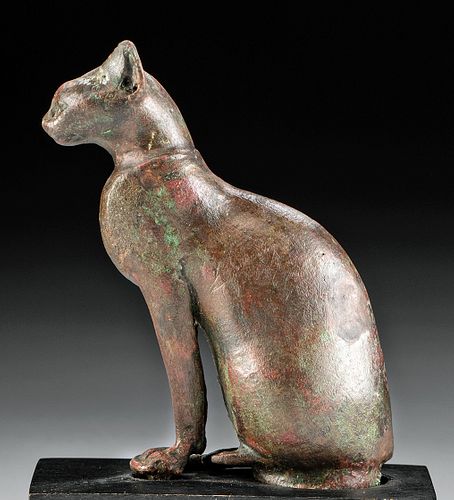Stunning Egyptian Late Dynastic Bronze Figure of Cat
Lot 11c
About Seller
Artemis Fine Arts
686 S Taylor Ave, Ste 106
Louisville, CO 80027
United States
Selling antiquities, ancient and ethnographic art online since 1993, Artemis Gallery specializes in Classical Antiquities (Egyptian, Greek, Roman, Near Eastern), Asian, Pre-Columbian, African / Tribal / Oceanographic art. Our extensive inventory includes pottery, stone, metal, wood, glass and textil...Read more
Estimate:
$5,000 - $7,500
Absentee vs Live bid
Two ways to bid:
- Leave a max absentee bid and the platform will bid on your behalf up to your maximum bid during the live auction.
- Bid live during the auction and your bids will be submitted real-time to the auctioneer.
Bid Increments
| Price | Bid Increment |
|---|---|
| $0 | $25 |
| $300 | $50 |
| $1,000 | $100 |
| $2,000 | $250 |
| $5,000 | $500 |
| $10,000 | $1,000 |
| $20,000 | $2,500 |
| $50,000 | $5,000 |
| $100,000 | $10,000 |
| $200,000 | $20,000 |
About Auction
By Artemis Fine Arts
Feb 13, 2020
Set Reminder
2020-02-13 10:00:00
2020-02-13 10:00:00
America/New_York
Bidsquare
Bidsquare : Exceptional Antiquities, Asian, Ethnographic
https://www.bidsquare.com/auctions/artemis-gallery/exceptional-antiquities-asian-ethnographic-4848
An important one-day auction featuring museum-worthy examples of Egyptian, Greek, Roman, Etruscan, Near Eastern, Far East / Asian, Pre-Columbian, African / Tribal, Oceanic, Native American, Spanish Colonial, Russian, Fossils, Ancient Jewelry, Fine Art, so much more! Artemis Fine Arts info@artemisfinearts.com
An important one-day auction featuring museum-worthy examples of Egyptian, Greek, Roman, Etruscan, Near Eastern, Far East / Asian, Pre-Columbian, African / Tribal, Oceanic, Native American, Spanish Colonial, Russian, Fossils, Ancient Jewelry, Fine Art, so much more! Artemis Fine Arts info@artemisfinearts.com
- Lot Description
Egypt, Late Dynastic to Ptolemaic Period, ca. 664 to 30 BCE. An exquisite cast-bronze figure of a cat of an instantly recognizable Egyptian style, seated upon its plump haunches with its sinuous tail wrapped around its hind legs and fore paws. The seated feline relaxes with its back gently arched and its chest protruding forward in a patient, defensive pose with its weight leaned over the front legs as if ready to strike at the first mouse it sees. The head rests atop a tapered neck and features a charming countenance defined by almond eyes, a tapered snout, a thin mouth with lightly impressed corners, and a pair of pierced ears. Cats were some of the most important and highly symbolic animals in Egyptian mythology, and figures like this were perhaps created as votive offerings to the Bastet, the goddess of cats or Sekhmet, the lioness-headed goddess of war. Gorgeous areas of brown, green, and russet patina have formed across the composition. Size: 3.875" L x 1.5" W x 3.6" H (9.8 cm x 3.8 cm x 9.1 cm); 4.5" H (11.4 cm) on included custom stand.
The ancient Egyptians, rather uniquely among the world's civilizations, had an obsession with cats, both tame and fierce, large and small. Cats were domesticated to help protect crops from pests in Cyprus or possibly Mesopotamia (it is difficult to interpret the archaeological record on this matter for a variety of reasons), but the Egyptian love of cats seems to have gone above and beyond that of their contemporaries. The cemetery at Hierakonpolis includes a cat skeleton in a pre-Dynastic tomb (ca. 3700 BCE) that had a broken left humerus and right femur that seem to have been set by a human and allowed to heal before that cat's ultimate death. The first illustration of a cat with a collar comes from a 5th Dynasty (ca. 2500 to 2350 BCE) Egyptian tomb at Saqqara. Cats were the most frequently mummified animal in Egypt and there were multiple feline goddesses, including the domesticated cat-form Bastet.
Bastet was initially a lioness goddess associated with the solar god and channeled its destructive power. However, by the early first millennium BCE, she assumed a more domestic feline form and became understood as a goddess of fertility and a guardian of the home. Ever since, statuettes comprised of various materials have characterized her as a doting mother cat. Her cult expanded decisively when her town in Bubastis (derived from per Bastet or "house of Bastet"), became the royal residence of the kings of the 22nd Dynasty, during the 10th century BCE. The city hosted an annual festival honoring Bastet in celebration of the Nile flood waters, and she was honored throughout Egypt through the first millennium BCE.
For a strikingly similar example, please see The Metropolitan Museum of Art, accession number 66.99.145.
A stylistically similar example, of a larger size, hammered for $10,625 at Sotheby's, New York "Egyptian, Classical, and Western Asiatic Antiquities" auction (June 3, 2015, lot 20).
Another stylistically similar example, of a larger size, hammered for GBP 40,000 ($52,752.80) at Christie's, London "The Resandro Collection" auction (sale 14490, December 6, 2016, lot 138).
Provenance: ex-Norman Blankman collection, New York, USA, acquired in 1959
All items legal to buy/sell under U.S. Statute covering cultural patrimony Code 2600, CHAPTER 14, and are guaranteed to be as described or your money back.
A Certificate of Authenticity will accompany all winning bids.
We ship worldwide and handle all shipping in-house for your convenience.
#153166Repaired from a few large pieces, with restoration to much of chest and shoulders, and resurfacing and overpainting along new material and break lines. Abrasions and nicks to head, body, legs, base, and lower tenons, with softening to some facial details, light encrustations, and slight bending to one foot. Light earthen deposits and wonderful patina throughout.Condition
- Shipping Info
-
All shipping is handled in-house for your convenience. Your invoice from Artemis Gallery will include shipping calculation instructions. If in doubt, please inquire BEFORE bidding for estimated shipping costs for individual items.
-
- Buyer's Premium



 EUR
EUR CAD
CAD AUD
AUD GBP
GBP MXN
MXN HKD
HKD CNY
CNY MYR
MYR SEK
SEK SGD
SGD CHF
CHF THB
THB














